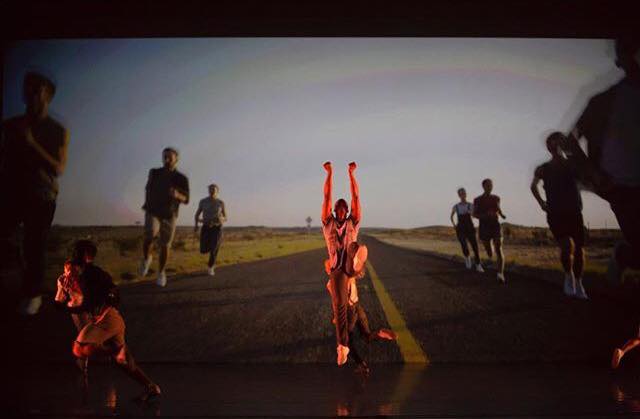
Tyler Peck’s Murder Ballades teems with energy in L.A. Dance Project production (photo by Rose Eichenbaum)
The Joyce Theater
175 Eighth Ave. at 19th St.
June 13-25, $26-$66
212-242-0800
www.joyce.org
www.ladanceproject.com
Upon entering the Joyce on Saturday night, June 17, to see Benjamin Millepied’s L.A. Dance Project, we were sad to hear that the performance of the brand-new duet In Silence We Speak had been canceled due to an injury. However, the three pieces that remained, all very different, made up a program that still worked extremely well. First was New York City Ballet wunderkind Justin Peck’s 2013 Murder Ballades, his debut as a contemporary dance choreographer. The curtain is raised, revealing six pairs of sneakers onstage, in front of Sterling Ruby’s colorful abstract backdrop of vertical and horizontal bars. Stephanie Amurao, Aaron Carr, Julia Eichten, Nathan Makolandra, Robbie Moore, and Rachelle Rafailedes, all in casual modern-day dress (Peck did the costume design), enter, lace on the sneakers, and proceed to run around the stage, the buzz of sudden freedom in the air, as if Peck is breaking free of ballet en pointe, at least momentarily. (He continues to dance and choreograph for NYCB.) Over the course of six sections, the dancers appear to be having a great time as they divide into solos and duets, including a lovely pas de deux between Makolandra and Rafailedes, and intersect in fluid trios and a variety of lines and patterns. At one point, Carr actually pauses to look at Ruby’s painting, making sure we all acknowledge its grandeur. Peck displays an infectious glee with his vigorous movement language, although it can get repetitive and a little too showy, but it works breathlessly with Bryce Dessner’s energetic score and Brandon Stirling Baker’s pinpoint lighting.

L.A. Dance Project performance of Merce Cunningham’s MinEvent is exquisitely rendered (photo by James Welling)
Next was Merce Cunningham’s MinEvent, a 2006 majestic collage that is like a Mondrian canvas brought to glorious life. Arranged and staged by Silas Riener, it’s performed by Amurao, Carr, Eichten, Makolandra, Moore, David Adrian Freeland Jr., and Lilja Rúriksdóttir, wearing tight black costumes, designed by Millepied, marked with spare, rectilinear thin stripes of color, the women’s and men’s costumes mirror images of each other. The often staccato, almost mechanical abstract movement, sudden stops and starts that seem to presage voguing but with blank facial expressions, form Mondrian-esque geometric patterns, not just with the shapes of the bodies, but with how the lines on the costumes merge. John Cage’s “Music for Piano” is performed live by Adam Tendler, who is like a seventh dancer, having to stand so he can pluck the strings inside of the instrument in addition to playing the regular keys, the minimalist score balancing sound with silence.

Benjamin Millipied mixes live action with cinema in world premiere of Orpheus Highway at the Joyce (photo by Erin Baiano)
The evening concluded with Millepied’s adventurous, multimedia Orpheus Highway, making its world premiere at the Joyce. The piece is set to Steve Reich’s stirring “Triple Quartet,” played live by PUBLIQuartet, featuring Curtis Stewart and Jannina Norpoth on violin, Nick Revel on viola, and Amanda Gookin on cello. Wearing contemporary clothing and sneakers (the costumes were designed by Millepied), Morgan Lugo, Amurao, Carr, Eichten, Freeland Jr., Makolandra, Moore, Rúriksdóttir, and Janie Taylor (replacing Rafailedes) dance in front of a film of themselves (but with Rafailedes instead of Taylor) that Millepied shot in Marfa, Texas, on the local streets, down a narrow alley, and on an endless highway in the middle of nowhere. Freeland Jr. and Taylor reenact the tragic myth of Orpheus and Eurydice, as all the live dancers move in opposition to, in unison with, and completely differently from their screen doppelgängers. There’s a lot going on, so you’re not always sure where to look, and your mind can’t help but try to make sense of how the filmed images relate to the live ones, but just let it unfold without thinking too hard about it. In some ways, it’s an innovative combination of the two works that preceded it. The two-week Joyce run continues through June 25; Program A consists of Millepied’s Hearts & Arrows, Ohad Naharin’s Yag, and In Silence We Speak if Carla Korbës has recovered.